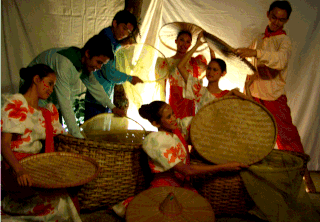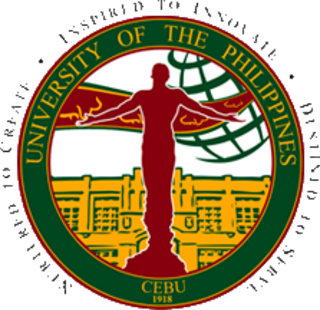
The Philippines, officially the Republic of the Philippines, is an archipelagic country in Southeast Asia. Situated in the western Pacific Ocean, it consists of about 7,641 islands that are broadly categorized under three main geographical divisions from north to south: Luzon, Visayas, Mindanao. The capital city of the Philippines is Manila and the most populous city is Quezon City, both within the single urban area of Metro Manila. Bounded by the South China Sea to the west, the Philippine Sea to the east, and the Celebes Sea to the southwest, the Philippines shares maritime borders with Taiwan to the north, Japan to the northeast, Palau to the east, Indonesia to the south, Malaysia and Brunei to the southwest, Vietnam to the west, and China to the northwest.

The economy of the Philippines is the world's 32nd largest economy by nominal GDP according to the International Monetary Fund 2020 and the 13th largest economy in Asia. The Philippines is one of the emerging markets and the 3rd highest in Southeast Asia by GDP nominal after Thailand and Indonesia.

Southeast Asia or Southeastern Asia is the southeastern subregion of Asia, consisting of the regions that are geographically south of China, east of the Indian subcontinent and north-west of Australia. Southeast Asia is bordered to the north by East Asia, to the west by South Asia and the Bay of Bengal, to the east by Oceania and the Pacific Ocean, and to the south by Australia and the Indian Ocean. Apart from the British Indian Ocean Territory and two out of 26 atolls of Maldives in South Asia, Southeast Asia is the only other subregion of Asia that lies partly within the Southern Hemisphere. The majority of the subregion is still in the Northern Hemisphere. East Timor and the southern portion of Indonesia are the only part that is south of the Equator.

Luzon is the largest and most populous island in the Philippines. It is ranked 15th largest in the world by land area. Located in the northern portion of the archipelago, it is the economic and political center of the nation, being home to the country's capital city, Manila, as well as Quezon City, the country's most populous city. With a population of 53 million as of 2015, it contains 52.5% of the country's total population and is the fourth most populous island in the world.

Ferdinand Emmanuel Edralin Marcos Sr. was a Filipino politician and kleptocrat who served as the 10th President of the Philippines from 1965 to 1986. Espousing an ideology of "constitutional authoritarianism" under the New Society Movement, he ruled as a dictator under martial law from 1972 until 1981, and kept most of his martial law powers until he was deposed in 1986. One of the most controversial leaders of the 20th century, Marcos' rule was infamous for its corruption, extravagance, and brutality.

Manila, officially the City of Manila, is the capital of the Philippines, second most populous and a highly urbanized city. It is the most densely populated city proper in the world as of 2019. It was the first chartered city by virtue of the Philippine Commission Act 183 on July 31, 1901 and gained autonomy with the passage of Republic Act No. 409 or the "Revised Charter of the City of Manila" on June 18, 1949. Manila, alongside Mexico City and Madrid, was considered the world's original set of global cities due to its commercial networks being the first to traverse the Pacific Ocean, thus connecting Asia with the Spanish Americas, marking the first time in world history when an uninterrupted chain of trade routes circled the planet. Manila is also the second most natural disaster-afflicted capital city in the world next to Tokyo, yet it is simultaneously among the most populous and fastest growing cities in Southeast Asia.

Maria Gloria Macaraeg Macapagal Arroyo, often referred to by her initials GMA, is a Filipino academic and politician who served as the 14th president of the Philippines from 2001 until 2010. Before her accession to the presidency, she served as the 10th vice president of the Philippines from 1998 to 2001, and was a senator from 1992 to 1998. After her presidency, she was elected as the representative of Pampanga's 2nd district in 2010 and later became the Speaker of the House of Representatives from 2018 until her retirement in 2019. She is the first woman to hold two of the highest offices in the country: Vice President and Speaker of the House.

The president of the Philippines is the head of state and the head of government of the Philippines. The president leads the executive branch of the Philippine government and is the commander-in-chief of the Armed Forces of the Philippines. The president is directly elected by the people, and is one of only two nationally elected executive officials, the other being the vice president of the Philippines. However, four vice presidents have assumed the presidency without having been elected to the office, by virtue of a president's intra-term death or resignation.

The People Power Revolution, also known as the EDSA Revolution, was a series of popular demonstrations in the Philippines, mostly in Metro Manila, from February 22–25, 1986. There was a sustained campaign of civil resistance against regime violence and electoral fraud. The nonviolent revolution led to the departure of Ferdinand Marcos, the end of his 20-year presidential term and the restoration of democracy in the Philippines.

The culture of the Philippines is a combination of cultures of the East and West. Filipino identity was created primarily as a result of pre-colonial cultures, colonial influences and foreign traders intermixing and gradually evolving together. In pre-colonial times, the Philippines was a divided set of nations, islands and tribes being ruled by their own kings, chieftains, lakans, rajahs, datus and sultans. Every nation has its own identity and some are even part of a larger empire outside of what is now the Philippines. Manila, for example, was once part of the Islamic Sultanate of Brunei, and the Sulu Archipelago was also part of the Hindu Majapahit. The advent of colonial rule in the islands marked the beginning of the Philippines as an entity, a collection of Southeast Asian countries united under Spanish Empire.

There are some 120 to 187 languages spoken in the Philippines, depending on the method of classification. Almost all are Malayo-Polynesian languages native to the archipelago. A number of Spanish-influenced creole varieties generally called Chavacano are also spoken in certain communities. The 1987 constitution designates Filipino, a standardized version of Tagalog, as the national language and an official language along with English. Filipino is regulated by Komisyon sa Wikang Filipino and therefore serves as a lingua franca used by Filipinos of various ethnolinguistic backgrounds.

Emmanuel "Manny" Dapidran Pacquiao, CLH is a Filipino professional boxer and Senator of the Philippines. Nicknamed "PacMan", he is regarded as one of the greatest professional boxers of all time. He was elected as Senator of the Philippines in 2016 and is serving a six-year term.

Filipinos are the people who are native to or citizens of the country of the Philippines. Filipinos come from various Austronesian ethnolinguistic groups. Currently, there are more than 185 ethnolinguistic groups in the Philippines; each with its own language, identity, culture and history. The number of individual languages listed for Philippines is 185. Of these, 183 are living and 2 are extinct. Of the living languages, 175 are indigenous and 8 are non-indigenous. Furthermore, as of 2019, 39 are institutional, 67 are developing, 38 are vigorous, 28 are endangered, and 11 are dying.

The Philippines is inhabited by more than 175 ethnolinguistic nations, the majority of whose languages are Austronesian in origin. Many of these nations converted to Christianity, particularly the lowland-coastal nations, and adopted foreign elements of culture. Ethnolinguistic nations include the Ilocano, Ivatan, Pangasinan, Kapampangan, Tagalog, Bicolano, Visayans, Zamboangueño, Subanon, and more.

The Catholic Church in the Philippines is part of the worldwide Catholic Church, under the spiritual direction of the Pope. The Philippines is one of the two nations in Asia having a substantial portion of the population professing the Catholic faith, along with East Timor, and has the third largest Catholic population in the world after Brazil and Mexico. The episcopal conference responsible in governing the faith is the Catholic Bishops' Conference of the Philippines.

Tourism is an important sector for Philippine economy. In 2019, the travel and tourism industry contributed 12.7% to the country's GDP. Philippines is an archipelagic country composed of 7,641 islands with 82 provinces divided in 17 regions. The country is known for having its rich biodiversity as its main tourist attraction. Its beaches, heritage towns and monuments, mountains, rainforests, islands and diving spots are among the country's most popular tourist destinations. The country's rich historical and cultural heritage, including its festivals and indigenous traditions, are also one of the attractions of Philippines. Popular destinations among tourists are Cebu, Boracay, Palawan, Siargao, and many more. However, despite these large potential, the tourist industry of the Philippines has lagged behind its Southeast Asian fellows like Thailand, Vietnam, Malaysia, Singapore and Indonesia, due to political and social problems.

The University of the Philippines Cebu is a public research university and the youngest constituent university of the University of the Philippines System located in Cebu City, the capital city of Cebu province in the Philippines. It was founded on May 3, 1918, ten years after the founding of UP in 1908.

Anti-Filipino sentiment refers to the general dislike or hatred towards the Philippines, Filipinos or Filipino culture. This can come in the form of direct slurs or persecution, in the form of connoted microaggressions, or depictions of the Philippines or the Filipino people as being inferior in some form psychologically, culturally or physically.
Ati (Inati) is an Austronesian language of the island of Panay in the Philippines. The variety spoken in northern Panay is also called Sogodnin. The Ati people also speak Kinaray-a and Hiligaynon.

Mary Jean "MJ" Ramirez Lastimosa is a Filipino-Arabian fashion model, actress, television presenter and beauty pageant titleholder who was crowned Miss Universe Philippines 2014 and placed as a Top 10 finalist in Miss Universe 2014.